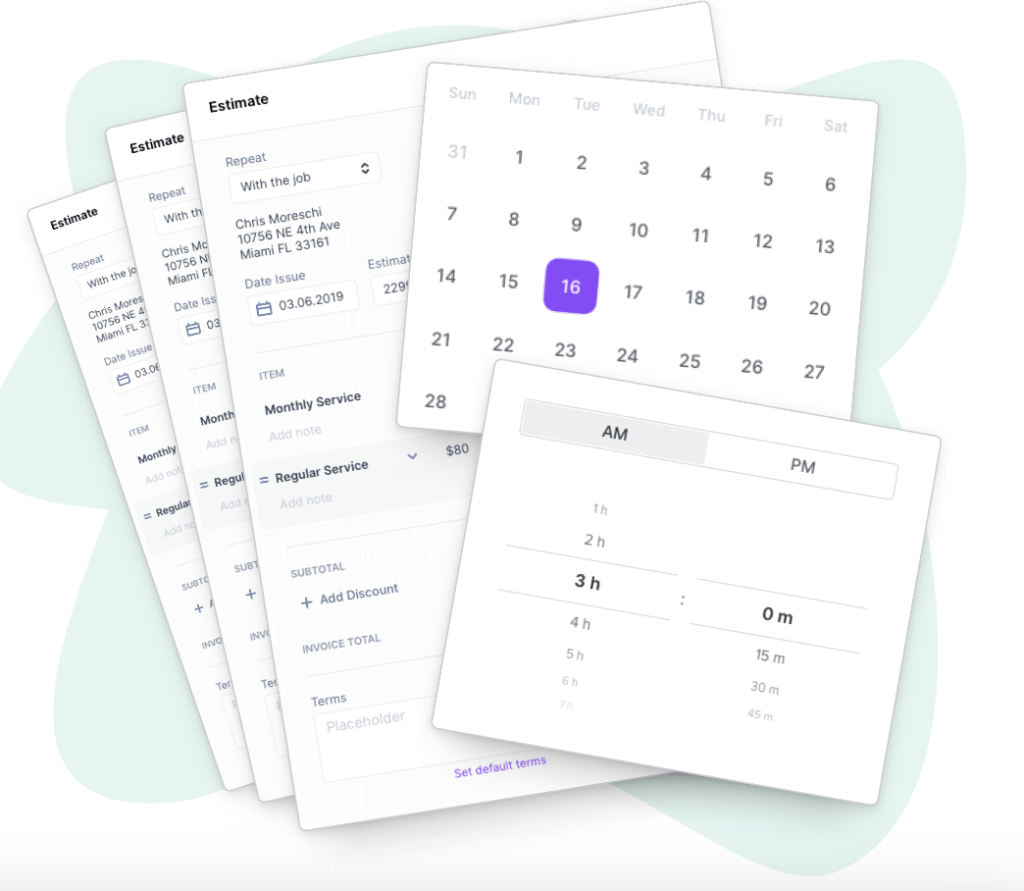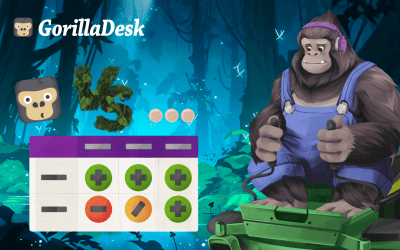3 pest control tools for every technician’s toolbox
GorillaDesk Staff

Are you struggling to juggle all the different aspects of your pest control business? Maybe it feels impossible to generate new leads while dealing with current customer demands, and on top of those major initiatives, maybe your technicians are complaining that their tools just aren’t cutting it.
This scenario probably sounds familiar — and you’re not alone.
Pest control can feel like an uphill battle at times, especially for a small business owner. It’s key to have pest control equipment you trust for the job since using the wrong equipment can majorly impact your efficiency, effectiveness, and customer satisfaction.
In this article, we’ll dive into the essential pest control tools for your toolbox—from inspection equipment to advanced pest control software solutions—so you can navigate your everyday operations with more confidence.
Different types of pest control tools
The “right tools” might look different for every operation, but several key categories factor into your toolbox. From essential inspection gear to cutting-edge technology solutions, let’s break down how each tool category can smooth out your operations.
1) Inspection tools
When in the field, we get that you need inspection tools to identify pest infestations and assess the problem’s extent. Flashlights aid in spotting hidden insects (like flies or ants), magnifying glasses help with detailed inspections for tiny pests, moisture meters detect damp areas that attract pests, and thermal imaging cameras reveal hidden pest activity.
With these tools, your technicians can quickly and accurately pinpoint issues and eliminate pests, which saves time and resources.
2) Treatment equipment
Once you’ve identified which pests are in the area, you’ll need tools to eliminate them. Sprayers allow for precise pesticide application, dusters ensure thorough coverage in hard-to-reach areas, bait stations target specific insects—like ants—without harming non-target species, and traps capture crawling pests humanely.
Having reliable treatment equipment streamlines pest control efforts and allows you to properly apply liquid pesticides.
3) Personal protective equipment
Personal protective equipment (PPE) ensures your and your field teams’ safety. Gloves protect against chemical exposure, respirators filter out harmful fumes, goggles shield the eyes from splashes, and coveralls prevent skin-to-pesticide contact.
By prioritizing safety gear, owners demonstrate a commitment to employee well-being and compliance with safety regulations, which reduces the risk of accidents and liability issues.
4) Technology
We know what you may be thinking: software and pest control don’t traditionally go hand in hand. In fact, many pest control organizations still rely on pen and paper to schedule technician routes and keep track of customer data.
Advanced technology solutions like GorillaDesk automates scheduling and dispatching, streamline invoicing and payment processes, track job details and material usage, and facilitate communication with customers. In other words, it’s a modern way to grow your business without getting caught up in day-to-day operations and allowing essential details to slip through the cracks.
A note on investing in high-quality pest control equipment
Outside of hiring expert employees, investing in premium pest control equipment is a great way to ensure long-term success. Ideally, you’ll use your tools for decades, so it’s important to consider durability and effectiveness before you buy. Carefully vet suppliers and brands and look for those with a reputation for reliable products and responsive customer support.
When searching for top-tier technology, check out our Pest Control Software Buying Guide for a good starting point. You’ll want to consider each platform’s capabilities, like scheduling, routing, invoicing, reporting, and customer management.
Before you select your software, make sure you’ve investigated the following:
- Integrations: The platform will ideally integrate with your existing systems and workflows to avoid disruptions.
- Ease of use: A user-friendly interface is essential to reduce training time for your team and increase adoption.
- Customer support: Access to reliable customer support and robust training resources will help you maximize software utilization.
- Cost: Flexible pricing models that align with your budgetary needs make it easier to scale with the platform as your organization grows.
- Scalability: You’ll want pest control equipment that can adapt and grow alongside your organization to ensure that it remains effective as your operations expand or evolve.
The more boxes a tool can check, the better investment it’s likely to be. Whether it’s the latest piece of PPE or more reliable software, premium pest control equipment can improve your reputation and make your day-to-day work easier.
When to rent vs. buy pest control equipment
While buying pest control equipment is usually a better long-term investment for pest control operations, there are some cases where renting is a great alternative. Consider how frequently you’ll use the tools, the up-front and long-term costs, and any inclusions.
When to rent
If you only need a tool seasonally, like traps for rodents in the winter or treatments for rare pests, renting is a great option. It’s also more cost-effective, especially for tools with high up-front costs. Renting has some other advantages, too:
- Greater flexibility: Curious to try a new trap type or pesticide brand? If you rent equipment, you can try tools before committing to ownership.
- Reduced maintenance: Rental agreements often include maintenance and repairs, which can reduce additional costs.
While renting may be more cost-effective upfront, long-term rental expenses can add up quickly. You might also run into limited availability, especially if you’re renting a seasonal tool during peak season, which can cause delays that you can’t afford.
When to buy
If you’re going to use tools like sprayers or dusters for daily operations, buying makes more sense. Buying can also be more economical in the long run if you’re using the tool regularly. Other buying benefits include:
- Ownership: If you own a piece of equipment, you have full control over its use and availability without restrictions.
- Customization: You can customize or modify owned tools to suit situational needs without worrying about rental contracts.
If you have the cash on hand to buy a tool outright, buying from brands you trust is usually the better way to go.
3 pest control tools for operational efficiency
No matter what, you’ll need to invest in protective gear and treatment equipment.
What will set you apart from others, though, is technology. Pest control software streamlines operations improves scheduling accuracy and makes your job more manageable.
Let’s explore some top tools to consider.
1. GorillaDesk, a pest control content management system
Use GorillaDesk to send invoices to customers and automatically move deals forward. (Source)
GorillaDesk’s field service management software skyrockets productivity, making managing every aspect of your business easier. From automated invoicing to on-the-go scheduling, GorillaDesk enables optimal productivity.
It can also help owners take their pest control operations to the next level by improving customer experience. GorillaDesk’s pest control software features include a one-stop shop for customer communications, digital documents for easier paperwork processes, and even a portal so customers have complete account visibility.
2. Training and certification platforms
Online training programs and certifications are a great (and often necessary) way for pest control professionals to stay up-to-date on industry standards and safety protocols.
The Certified Training Institute, for example, offers a Pest Control Training & Applicator Recertification course, which is available on demand. Your teams can get a refresher that covers state certification requirements—all from their laptop at home.
Additionally, platforms like Pest Control Technology (PCT) Online and the National Pest Management Association (NPMA) offer a wide range of training modules and certifications tailored to different aspects of pest control, from general techniques to specialized treatments like termite control or wildlife management.
These resources not only help professionals stay compliant with regulations but also enhance their knowledge and skills, ultimately improving service quality and customer satisfaction.
3. IoT pest monitoring
Internet of Things (IoT) devices refer to a network of “smart” objects, like thermostats or speakers, that can connect to the internet and communicate with each other to perform tasks or gather data.
For pest control professionals, IoT devices include the following:
- Smart traps that alert technicians when they capture pests—which are especially useful in tight or enclosed spaces like utility closets, storage areas, or crawl spaces
- Environmental sensors that monitor temperature and humidity levels to determine pest activity
- Automated pest monitoring systems that provide real-time data for targeted interventions
IoT technology aids in proactive pest management strategies, reducing manual effort and making fieldwork easier.
Prioritizing efficient, high-quality tools for your pest control business
At the end of the day, you want to make your life (and your technicians’ lives) as easy as possible. Having the proper equipment can not only transform your business as it stands today but can also set you up for future success.
Investing in high-quality pest control equipment—from items your teams use in the field every day to software that will keep you from drowning in paperwork—ensures longevity. Most of the time, it’s better to spend the money on superior tools that will help your organization run smoothly than to skimp on the essentials. Pest control is a competitive industry, and the right equipment can set you apart.
It’s time to stop thinking about how you do business now and instead think about how technology and pest control equipment can help you do better business in the future. GorillaDesk’s pest control software can help you organize your operations, impress your customers, and improve team communication.
Start streamlining your operations by signing up for your 14-day free GorillaDesk trial today.
Other posts to check out
Make the move from paper to digital: A step-by-step guide for field service pros
If your field service business is still doing business on paper, it’s time to make a change. Here’s how to find success with a move to digital.
Pest control marketing: Let’s make that phone ring
With so many other local pest control companies making competition tight, keeping that phone ringing with new customers may not feel as easy as you thought. To keep your pest control business growing takes marketing know-how. Here are our best tips.
How to get more positive customer feedback
Customers trust online reviews just as much as word of mouth from friends and family. The truth is: Online reviews can make or break your local services business. Here’s how to build that glowing reputation your service deserves.
Tree service marketing: 11+ ideas to drive more customers in 2025
Drive more leads with our ultimate tree service marketing guide! Discover 11+ proven strategies to grow your business and attract the right customers.
How to start a tree service business in 2025
Learn how to start a tree service business with step-by-step guidance on planning, licensing, equipment, marketing, safety, and scaling your company.
Landscaping services list: What to offer your customers
Discover the top landscaping services to offer for maximum profit. From design to maintenance, expand your business with our comprehensive landscaping services list.
Transform your business
Try it free for 14 days. No credit card required. Instant setup.
★★★★★
We will be customers for life
“I can not say enough good things about GorillaDesk it saves us so much time and money. The customer service is the best. I would recommend GorillaDesk to anyone no matter what industry. I trained my employee in 5 minutes on how to use it. We will be customers for life.”

Ryan Sullivan
Business Owner
Ready to Get Started?
Get all our amazing features and top-rated support, with no credit card required.







